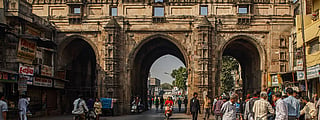
Ahmedabad, the dynamic core of Gujarat, is a city alive with history, culture, and trade. Think of its story as a beautiful mosaic, crafted from the influences of various dynasties, languages, and cultures, each adding to its rich legacy.
As with any city with such a remarkable past, it has had many names throughout the ages. Let’s take an exciting trip through the different names of Ahmedabad and the history behind each one!
Long before the city we know today as Ahmedabad came into existence, the region was known as Ashaval or Ashapalli. This was around the 11th century when the area was a thriving settlement ruled by a Bhil Maharaja Aasha Bhil.
Ashaval was a prominent center, bustling with trade and culture, nestled on the east banks of the Sabarmati River. The name itself suggests a deep-rooted connection with local traditions and the land.
As we move into the 12th century, Ashaval came under the rule of King Karna of the Chaulukya dynasty. He renamed it Karnavati, after himself. Karnavati grew as a significant hub of commerce and politics under his reign.
Even today, many locals affectionately refer to Ahmedabad as Karnavati, especially when speaking of its historical and cultural essence.
The name Ahmedabad, by which the city is globally recognised today, emerged in the 15th century. In 1411, Sultan Ahmed Shah of the Muzaffarid dynasty established the city, naming it Ahmedabad after himself.
Legend has it that the Sultan decided to build the city on the spot where he saw a hare chasing a dog, a sign of the area's special protective spirit. Ahmedabad quickly grew into a thriving center of trade, architecture, and culture under his patronage.
In the 19th and early 20th centuries, during the British colonial period, Ahmedabad earned its nickname "The Manchester of India". This was due to its booming textile industry, which paralleled that of Manchester in England. The city’s numerous mills and factories were at the heart of India's textile production, making it a crucial economic center.
In 2017, Ahmedabad was declared India's first UNESCO World Heritage City. This prestigious title reflects its rich architectural and cultural heritage, encompassing historic monuments, pols, and bustling markets.
Fast forward to modern times, and you’ll hear the locals referring to their beloved city as Amdavad. This colloquial version of Ahmedabad reflects the city's dynamic, easy-going spirit.
From Ashaval to Karnavati, Ahmadabad to Amdavad, and from the Manchester of India to World Heritage City, the city has worn many names, each reflecting a different facet of its vibrant personality.
No matter what you call it, Ahmedabad remains a city of warmth, resilience, and endless charm, where the past and the future coexist harmoniously. Whether you’re strolling through its ancient pols, savoring its street food, or witnessing its modern skyscrapers, you’re walking through a living history that continues to evolve with time!
To get all the latest content, download our mobile application. Available for both iOS & Android devices.